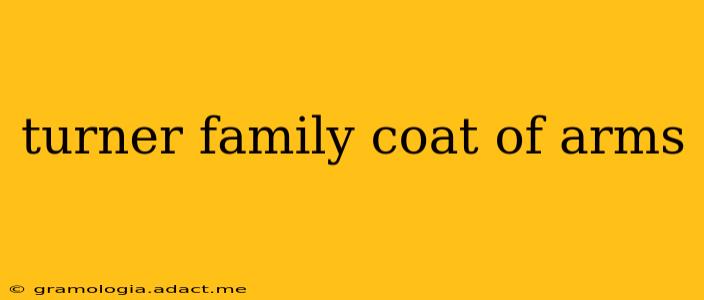The Turner surname boasts a rich history, and with it, a fascinating array of coats of arms. Unlike a single, universally recognized crest for all Turners, numerous variations exist, reflecting the diverse geographical origins and branching family lines of those bearing the name. This guide will explore the complexities surrounding Turner family coats of arms, helping you understand their significance and how to trace your own potential heraldic heritage.
What is a Coat of Arms?
Before diving into the specifics of Turner arms, it's crucial to understand what a coat of arms represents. A coat of arms, or heraldic achievement, is a symbolic emblem historically granted to individuals or families by a sovereign authority, typically a king or queen. These emblems were used to distinguish individuals on the battlefield, in tournaments, and in official documents. The design, including charges (symbols), tinctures (colors), and motto, held specific meanings, often reflecting the family's history, achievements, and values.
Are There Different Turner Coats of Arms?
Yes, absolutely. The existence of multiple Turner coats of arms is a direct result of the surname's widespread use and diverse origins. The name Turner itself is descriptive, referring to someone who worked as a turner – a craftsman who shaped wood or metal on a lathe. This occupation was prevalent across various regions and time periods, leading to many families independently adopting the surname. Each of these families, potentially with different lineages and regional connections, might have been granted – or designed – their own unique coat of arms.
How Can I Find My Turner Family Coat of Arms?
This is often the most challenging aspect for those researching their family history. There's no single, central database for all coats of arms. The process requires genealogical research to identify your specific family line and its geographic location. Here's a step-by-step approach:
-
Genealogical Research: Start by constructing your family tree. Trace your lineage as far back as possible, documenting birthplaces, marriage records, and other vital information. This will help pinpoint the region and approximate time period of your ancestors' origins.
-
Geographic Focus: Once you have a clearer understanding of your family's origins, focus your search on that specific region. Heraldic records are often kept at a national or regional level, so knowing where your ancestors lived is essential.
-
Consult Heraldic Records: Many national archives and heraldic societies hold records of granted coats of arms. You may need to consult different archives based on your ancestors' locations (e.g., the College of Arms in England, the Court of the Lord Lyon in Scotland).
-
Professional Help: If your research proves too complex or you encounter difficulties, consider contacting a professional genealogist or heraldic researcher. They have the expertise and resources to navigate complex archival records.
What if I Can't Find a Coat of Arms for My Family?
Not finding a historically documented coat of arms for your family doesn't mean one doesn't exist, or that your family isn't important! It simply means that either the coat of arms wasn't formally recorded, or its record has been lost to time. Many families, particularly those without significant titles or wealth, may not have had the means to obtain or register a coat of arms.
Can I Create My Own Turner Coat of Arms?
While you can design a personal coat of arms representing your family's values and heritage, it's crucial to understand that it will not be a historically accurate or officially recognized heraldic achievement. Officially granted coats of arms are unique and protected by law. Creating your own is a matter of personal expression and should be clearly distinguished from a genuine, historically-granted coat of arms.
What are some common symbols found in Turner coats of arms?
While specific symbols vary wildly depending on the individual family’s coat of arms, you might find representations of tools associated with turning wood or metal, such as a lathe or a chisel, reflecting the original meaning of the surname. Other symbols might relate to the family’s geographic location or historical achievements.
Is it expensive to research a Turner coat of arms?
The cost can vary significantly depending on the extent of the research required and whether you employ professional assistance. Accessing archival records may involve fees, and professional genealogists and heraldic researchers charge for their services.
This exploration of Turner family coats of arms highlights the intricate nature of heraldic research. While finding your family's specific coat of arms can be a challenging yet rewarding endeavor, the journey provides valuable insight into your ancestry and heritage. Remember that careful genealogical research is paramount to any successful search.
